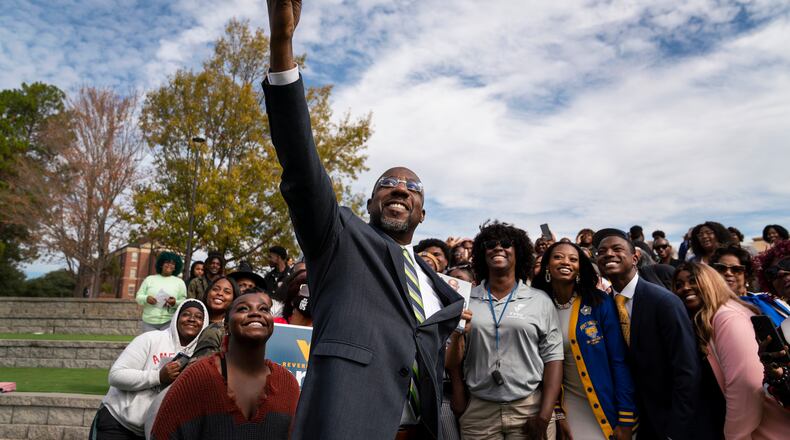Sen. Raphael Warnock’s reelection sparked social media posts from around the country thanking Georgia for solidifying the Democratic majority in the U.S. Senate, thanking Stacey Abrams for her get-out-the-vote initiatives and DeKalb County for its 87% support of Warnock.
Should some of that gratitude go to Georgia students?
“Yes, there should be a ‘Thank you, young Georgia,’” said Clark Atlanta University sophomore Jayden Williams, who, as president of the Georgia NAACP Youth and College Division, helped drive student turnout. “But we don’t need a divided Georgia. We need a one Georgia, so saying, ‘Thank you, Georgia’ should hit every age group.”
Credit: Contributed
Credit: Contributed
“Young people’s greatest contribution to Warnock’s win was our odds-defying turnout, our enthusiasm as wind in the sails of his campaign,” said Georgia Tech student and Georgia Youth Justice Coalition co-founder Alex Ames. “No singular age group can be credited. Black-led organizations like Black Voters Matter and so many Georgia voters including Gen Z made this possible.”
Ames and Williams were among the college activists on war room calls with other Gen Z leaders across Georgia to devise strategies to catalyze students. With only 28 days between the midterm election and the runoff, they acted with urgency, initially focused on how to lobby for weekend voting and ensure enough campus voting places.
“Once we fixed those issues, we pivoted to voter access,” said Ames. “Our goal was collaboration as we didn’t want these groups stepping on each other’s toes or want groups all on one campus on the same day. It is easy to inherit a broken politics and reject hope and voting. It is hard and necessary to vote and mobilize others despite our sometimes-discouraging political system.”
Credit: Contributed
Credit: Contributed
Williams said students understood what was at stake — a woman’s right to control her own body, protection from gun violence, voting rights and full equality under the law. The challenge facing him and other young leaders was making the case to their peers “why it’s important to register to vote and to vote in every single election,” he said.
It paid off.
More of them came to the polls. Georgia Secretary of State data shows that Generation Z voters — born in the late 1990s through the early 2010s — outpaced voters ages 25 to 34 in absentee and early voting.
At a Warnock rally at Georgia Tech on the eve of the runoff, fired-up Florida U.S. Rep.-elect Maxwell Frost, 25, the first Gen Z member elected to the U.S. Congress, told the crowd, “We know that young people don’t make up the biggest voting bloc right now. But we are the bloc that matters. We are the bloc that decides the margins. This is the bloc that elected Sen. Rev. Raphael Warnock two years ago, and this is the bloc that is going to elect him now.”
Warnock courted the student vote in the last weeks of his campaign, visiting his alma mater, Morehouse College, the University of Georgia, Fort Valley State, Kennesaw State, Albany State and the University of West Georgia. GOP opponent Herschel Walker seemed to discount student voters.
Nationwide, young people, who lean strongly Democratic, defied midterm expectations, according to the Center for Information & Research on Civic Learning and Engagement (CIRCLE) at Tufts University, an independent research organization focused on youth civic engagement. In the November elections, an estimated 27% of voters nationally ages 18-29 cast ballots, making it the second-highest youth voter turnout in almost three decades, according to CIRCLE. And in Georgia, those young voters went for Warnock 63% to 34%.
While still waiting for more data from the Dec. 6 runoff, Kei Kawashima-Ginsberg, the Newhouse director of CIRCLE, said, “Every indicator is that there was a huge majority of young people in Georgia supporting Warnock. If that trend in the general election for youth holds the same, then young people were likely influential in the runoff.”
One of the major causes of low turnout among young people is lack of information about the voting process, said Kawashima-Ginsberg. This was not helped when the Georgia General Assembly moved up the date for the runoff as it made it more difficult for groups and organizations working directly with voters to educate and mobilize them, she said. CIRCLE’s research found that outreach to young voters by political parties and campaigns correlates strongly with higher self-reported turnout rates.
Jordan Tildon, 24, a University of Georgia graduate, worked to rally young voters as a community liaison for the local advocacy group BlackPush. She organized a well-attended voter registration event at Morris Brown College.
But Tildon also reinforced the message by talking to her friends in person and on social media, reminding them, “We need to make sure we are heard. If we would vote, we could see more changes.”
About the Author
The Latest
Featured





